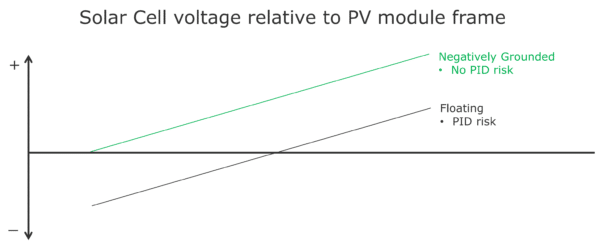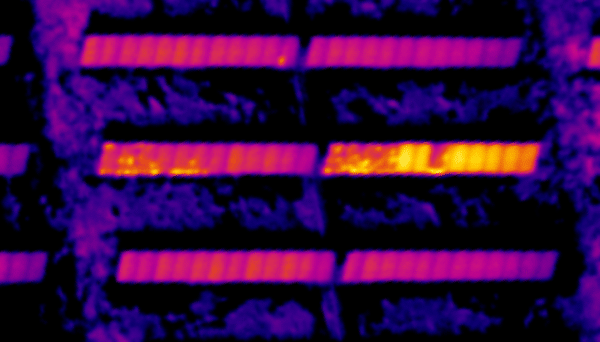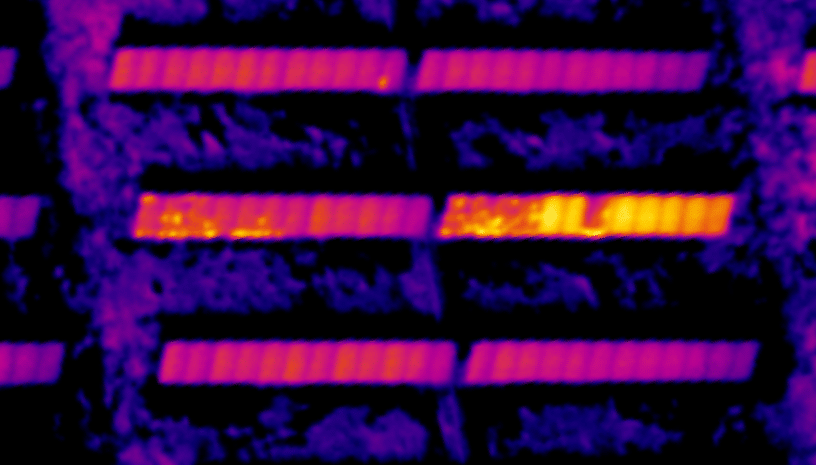Editor’s note: This article is the first in a series discussing specific system reliability issues seen in North America. Each article will focus on a specific failure mode, giving an overview and examples of defect presentation, followed by a longer summary article diving into a broader industry context and defect prevalence will follow this series. This first article focusing on PID is a collaboration between Heliolytics and DNV GL.
By Dr. Rob Andrews and Kristine Sinclair (Heliolytics) and Tom McNulty, Raymond Hudson and Frederic Dross (DNV GL)
Potential Induced Degradation (PID) is a defect experienced by some PV modules when installed such that the PV cells are operated at a negative voltage with respect to ground (module frames are electrically grounded). The greater the negative potential difference relative to ground, the more severe the PID effect. However, not all module designs are inclined to PID and not all system designs trigger the failure mechanism (see Figure 1).

DNV-GL
PID risk can be mitigated by designing the PV system to avoid exposing the modules to negative bias relative to ground (standard in North America), designing the system to reverse the voltage on the modules periodically to reverse the effects of PID, or designing the modules to not be susceptible to exposure. Unfortunately, each of these approaches have drawbacks:
– Advanced system designs targeting more efficient or safer operation often require at least part of the array exposed to negative voltage.
– System designs that periodically reverse the effects of PID spend time operating with some level of active PID, and an imperfect degree of reversibility may lead to progressive impacts over time.
– Modules designed for minimal susceptibility to PID are still relatively recently deployed in the field and are under active research. In addition, low conductivity encapsulants to protect susceptible cells lack redundancy and are susceptible to quality control deviations and component degradation over time. DNV GL therefore recommends testing for PID (for instance to the existing standard IEC 62804) a sample of the modules sent to the project site.
Although PID is rare in North America due electrical system design regulations avoiding the conditions that allow for PID to occur, it has been observed by Helioytics. The thermal image below presents two strings at different stages of exhibiting PID, surrounded by strings without this issue. The root-cause has been traced back to a fault in electrical Balance of System equipment, resulting in improper grounding. In the string on the left, the progression of PID is less advanced. The modules on the left half of the string see a negative bias relative to ground and show multiple local hot-spots due to cell degradation.

Heliolytics
For the string on the right of this example image, the modules suffering from PID have degraded to an extent that they are significantly limiting power production of the string. The modules to the right of the string are not degraded but are forced to operate off of their maximum power point. Excess power produced is lost as heat within the modules, and they run hot compared to surrounding strings, but with a uniform instead of “speckled” appearance. Another example of a similar presentation of PID is shown below.

Heliolytics
The two sites highlighted in this article are from different regions in the US, and represent different owners, operators, and module manufacturers. Although Although PID is less frequent in the US than in the rest of the world, it needs to be considered by system operators and owners. A combination of lab and field tests supported by engineering understanding is an efficient approach to identify and mitigate PID.
Want to learn more about quality issues with PV plants? Be sure to attend pv magazine’s Quality Roundtable at the Solar Power International trade show on September 12 in Las Vegas. Register here.
This content is protected by copyright and may not be reused. If you want to cooperate with us and would like to reuse some of our content, please contact: editors@pv-magazine.com.








By submitting this form you agree to pv magazine using your data for the purposes of publishing your comment.
Your personal data will only be disclosed or otherwise transmitted to third parties for the purposes of spam filtering or if this is necessary for technical maintenance of the website. Any other transfer to third parties will not take place unless this is justified on the basis of applicable data protection regulations or if pv magazine is legally obliged to do so.
You may revoke this consent at any time with effect for the future, in which case your personal data will be deleted immediately. Otherwise, your data will be deleted if pv magazine has processed your request or the purpose of data storage is fulfilled.
Further information on data privacy can be found in our Data Protection Policy.